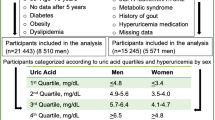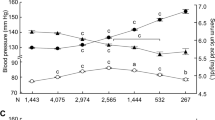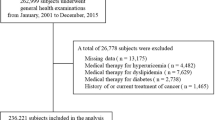Abstract
We tested the hypothesis that uric acid levels predict new-onset hypertension in the Japanese general population. Normotensive individuals who visited our hospital for a yearly health checkup (n=8157, men=61.0% and age=50.7±12.2 years) were enrolled in the present study. After baseline evaluation, participants were followed up for a median of 48.3 months (range 4.9–101.0 months), with the endpoint being the development of hypertension, defined as systolic blood pressure (BP) ⩾140 mm Hg, diastolic BP ⩾90 mm Hg or the use of antihypertensive medication. The impact of uric acid and other cardiovascular risk factors at baseline on future BP and development of hypertension was assessed. During follow-up, 19.0% of women (n=605) and 29.5% of men (n=1 469) participants developed hypertension. Incident hypertension was increased across the quartiles for baseline uric acid levels (P<0.0001), and multivariate Cox proportional hazards analysis revealed a significant and independent association between the uric acid level and the onset of hypertension in both men and women participants (P<0.05). Furthermore, uric acid was independently and positively correlated with future BP (P<0.05). Thus, uric acid is an independent predictor of new-onset hypertension in both women and men.
This is a preview of subscription content, access via your institution
Access options
Subscribe to this journal
Receive 12 digital issues and online access to articles
$119.00 per year
only $9.92 per issue
Buy this article
- Purchase on Springer Link
- Instant access to full article PDF
Prices may be subject to local taxes which are calculated during checkout

Similar content being viewed by others
References
Kannel WB . Hypertension as a risk factor for cardiac events: epidemiologic results of long-term studies. J Cardiovasc Pharmacol 1993; 21 (Suppl 2): S27–S37.
Whelton PK, He J, Appel LJ, Cutler JA, Havas S, Kotchen TA et al. Primary prevention of hypertension: clinical and public health advisory from The National High Blood Pressure Education Program. JAMA 2002; 288: 1882–1888.
Chobanian AV, Bakris GL, Black HR, Cushman WC, Green LA, Izzo JL Jr et al. Seventh report of the Joint National Committee on Prevention, Detection, Evaluation, and Treatment of High Blood Pressure. Hypertension 2003; 42: 1206–1252.
Ogihara T, Kikuchi K, Matsuoka H, Fujita T, Higaki J, Horiuchi M et al. The Japanese Society of Hypertension guidelines for the management of hypertension (JSH 2009). Hypertens Res 2009; 32: 3–107.
Mancia G, Fagard R, Narkiewicz K, Redón J, Zanchetti A, Böhm M et al. 2013 ESH/ESC Guidelines for the management of arterial hypertension: the task force for the management of arterial hypertension of the European Society of Hypertension (ESH) and of the European Society of Cardiology (ESC). J Hypertens 2013; 31: 1281–1357.
Takase H, Dohi Y, Toriyama T, Okado T, Tanaka S, Sato K et al. Metabolic disorders predict development of hypertension in normotensive Japanese subjects. Hypertens Res 2008; 31: 665–671.
Najjar SS, Scuteri A, Shetty V, Wright JG, Muller DC, Fleg JL et al. Pulse wave velocity is an independent predictor of the longitudinal increase in systolic blood pressure and of incident hypertension in the Baltimore Longitudinal Study of Aging. J Am Coll Cardiol 2008; 51: 1377–1383.
Takase H, Dohi Y, Toriyama T, Okado T, Tanaka S, Sonoda H et al. Brachial-ankle pulse wave velocity predicts increase in blood pressure and onset of hypertension. Am J Hypertens 2011; 24: 667–673.
Takase H, Dohi Y, Toriyama T, Okado T, Tanaka S, Sonoda H et al. Evaluation of risk for incident hypertension using glomerular filtration rate in the normotensive general population. J Hypertens 2012; 30: 505–512.
Verdecchia P, Schillaci G, Reboldi G, Santeusanio F, Porcellati C, Brunetti P . Relation between serum uric acid and risk of cardiovascular disease in essential hypertension. The PIUMA Study. Hypertension 2000; 36: 1072–1078.
Fang J, Alderman MH . Serum uric acid and cardiovascular mortality the NHANES I epidemiologic follow-up study, 1971-1992. National Health and Nutrition Examination Survey. JAMA 2000; 283: 2404–2410.
Niskanen LK, Laaksonen DE, Nyyssönen K, Alfthan G, Lakka HM, Lakka TA et al. Uric acid level as a risk factor for cardiovascular and all-cause mortality in middle-aged men: a prospective cohort study. Arch Intern Med 2004; 164: 1546–1551.
Baker JF, Krishnan E, Chen L, Schumacher HR . Serum uric acid and cardiovascular disease: recent developments, and where do they leave us? Am J Med 2005; 118: 816–826.
Feig DI, Kang DH, Johnson RJ . Uric acid and cardiovascular risk. N Engl J Med 2008; 359: 1811–1821.
Kawai T, Ohishi M, Takeya Y, Onishi M, Ito N, Yamamoto K et al. Serum uric acid is an independent risk factor for cardiovascular disease and mortality in hypertensive patients. Hypertens Res 2012; 35: 1087–1092.
Farquharson C, Butler R, Hill A, Belch J, Struthers A . Allopurinol improves endothelial dysfunction in chronic heart failure. Circulation 2002; 106: 221–226.
Kanbay M, Huddam B, Azak A, Solak Y, Kadioglu GK, Kirbas I et al. A randomized study of allopurinol on endothelial function and estimated glomerular filtration rate in asymptomatic hyperuricemic subjects with normal renal function. Clin J Am Soc Nephrol 2011; 6: 1887–1894.
Yelken B, Caliskan Y, Gorgulu N, Altun I, Yilmaz A, Yazici H et al. Reduction of uric acid levels with allopurinol treatment improves endothelial function in patients with chronic kidney disease. Clin Nephrol 2012; 77: 275–282.
Noman A, Ang DS, Ogston S, Lang CC, Struthers AD . Effect of high-dose allopurinol on exercise in patients with chronic stable angina: a randomised, placebo controlled crossover trial. Lancet 2010; 375: 2161–2167.
Terawaki H, Nakayama M, Miyazawa E, Murata Y, Nakayama K, Matsushima M et al. Effect of allopurinol on cardiovascular incidence among hypertensive nephropathy patients: the Gonryo study. Clin Exp Nephrol 2013; 17: 549–553.
Sonoda H, Takase H, Dohi Y, Kimura G . Uric acid levels predict future development of chronic kidney disease. Am J Nephrol 2011; 33: 352–357.
Sundström J, Sullivan L, D’Agostino RB, Levy D, Kannel WB, Vasan RS . Relations of serum uric acid to longitudinal blood pressure tracking and hypertension incidence. Hypertension 2005; 45: 28–33.
Perlstein TS, Gumieniak O, Williams GH, Sparrow D, Vokonas PS, Gaziano M et al. Uric acid and the development of hypertension. Hypertension 2006; 48: 1031–1036.
Krishnan E, Kwoh CK, Schumacher HR, Kuller L . Hyperuricemia and incidence of hypertension among men without metabolic syndrome. Hypertension 2007; 49: 298–303.
Grayson PC, Kim SY, LaValley M, Choi HK . Hyperuricemia and incident hypertension: a systematic review and meta-analysis. Arthritis Care Res (Hoboken) 2011; 63: 102–110.
Loeffler LF, Navas-Acien A, Brady TM, Miller ER 3rd, Fadrowski JJ . Uric acid level and elevated blood pressure in US adolescents: National Health and Nutrition Examination Survey, 1999-2006. Hypertension 2012; 59: 811–817.
Matsuo S, Imai E, Horio M, Yasuda Y, Tomita K, Nitta K et al. Collaborators developing the Japanese equation for estimated GFR. Revised equations for estimated GFR from serum creatinine in Japan. Am J Kidney Dis 2009; 53: 982–992.
Yamanaka H and Japanese Society of Gout and Nucleic Acid Metabolism. Japanese guideline for the management of hyperuricemia and gout: second edition. Nucleosides Nucleotides Nucleic Acids 2011; 30: 1018–1029.
Iseki K, Ikemiya Y, Inoue T, Iseki C, Kinjo K, Takishita S . Significance of hyperuricemia as a risk factor for developing ESRD in a screened cohort. Am J Kidney Dis 2004; 44: 642–650.
Iseki K, Iseki C, Kinjo K . Changes in serum uric acid have a reciprocal effect on eGFR change: a 10-year follow-up study of community-based screening in Okinawa, Japan. Hypertens Res 2013; 36: 650–654.
Iseki K, Oshiro S, Tozawa M, Iseki C, Ikemiya Y, Takishita S . Significance of hyperuricemia on the early detection of renal failure in a cohort of screened subjects. Hypertens Res 2001; 24: 691–697.
Miyagawa K, Ohashi M, Yamashita S, Kojima M, Sato K, Ueda R et al. Increased oxidative stress impairs endothelial modulation of contractions in arteries from spontaneously hypertensive rats. J Hypertens 2007; 25: 415–421.
Libby P . Inflammation in atherosclerosis. Arterioscler Thromb Vasc Biol 2012; 32: 2045–2051.
Feig DI . Uric acid and hypertension. Semin Nephrol 2011; 31: 441–446.
Feig DI, Soletsky B, Johnson RJ . Effect of allopurinol on blood pressure of adolescents with newly diagnosed essential hypertension: a randomized trial. JAMA 2008; 300: 924–932.
Fox IH, Kelley WN . Studies on the mechanism of fructose-induced hyperuricemia in man. Metabolism 1972; 21: 713–721.
Eastmond CJ, Garton M, Robins S, Riddoch S . The effects of alcoholic beverages on urate metabolism in gout sufferers. Br J Rheumatol 1995; 34: 756–759.
Author information
Authors and Affiliations
Corresponding author
Ethics declarations
Competing interests
The authors declare no conflict of interest.
Rights and permissions
About this article
Cite this article
Takase, H., Kimura, G. & Dohi, Y. Uric acid levels predict future blood pressure and new onset hypertension in the general Japanese population. J Hum Hypertens 28, 529–534 (2014). https://doi.org/10.1038/jhh.2013.143
Received:
Revised:
Accepted:
Published:
Issue Date:
DOI: https://doi.org/10.1038/jhh.2013.143
Keywords
This article is cited by
-
Serum uric acid and new-onset hypertension: a possible therapeutic avenue?
Journal of Human Hypertension (2014)



